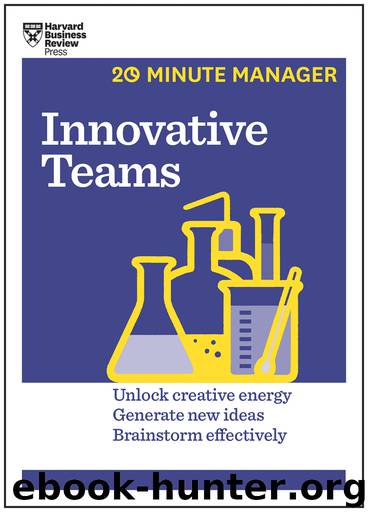Innovative Teams (HBR 20-Minute Manager Series) by Harvard Business Review

Author:Harvard Business Review
Language: eng
Format: epub
Publisher: Harvard Business Review Press
Published: 2015-03-06T05:00:00+00:00
Choosing the Right Option
Choosing the Right Option
Developing creative ideas can be exciting, but there’s a difference between an intriguing idea and a real business opportunity or viable solution. Moving from many options to a single path forward can be the trickiest part of the creative process. This chapter will help you narrow down the ideas you’ve generated and create a plan for implementation.
Evaluate useful ideas
It’s best to allot some time between your idea generation session and narrowing those ideas down. A few days or even a couple of weeks is ideal, but at a minimum, give your group a night to “sleep on it.” This will allow team members to consider their options and think deeply before commenting. During this time, new ideas may emerge, as well as sudden insights about which ideas may be best to pursue.
Once the incubation period has passed, reconvene your team for convergent thinking, in which a team shifts its focus from generating novel ideas to considering which of those ideas are useful. The convergent thinking process tempers creativity with discipline, helping you channel the results of idea generation into a new product, service, process improvement, or solution to a problem.
During idea generation, judgment and critical thought were banished. Now it’s time to invite those qualities back into the room. At this point in the process, you’ll define the constraints you’re working with and ask challenging questions to rule out the ideas that don’t seem feasible. You’ll identify the best ones to pursue and then assess how best to proceed.
It’s important to welcome—even encourage—dissent during convergent thinking. Your team should feel free to disagree and express contrary views, as long as that doesn’t escalate into unproductive conflict. (See the sidebar “Handling interpersonal conflict” for advice on how to prevent and alleviate this type of tension.) If you find that your team quickly converges into comfortable agreement, don’t settle too early: Assign someone to be a devil’s advocate to challenge assumptions. An opposing viewpoint can help members reexamine their positions and make a better choice.
Narrow down your list
The work of convergence involves setting limits: narrowing the field of options using a given set of constraints. Once defined, constraints can help you rule out options that are beyond the scope of your project or are a poor fit for your organization. Consider your company’s culture, mission, priorities, and resources, as well as the purpose of your creative project, and evaluate each option your team generated according to these criteria.
Download
Innovative Teams (HBR 20-Minute Manager Series) by Harvard Business Review.epub
This site does not store any files on its server. We only index and link to content provided by other sites. Please contact the content providers to delete copyright contents if any and email us, we'll remove relevant links or contents immediately.
Tools of Titans by Timothy Ferriss(8183)
Change Your Questions, Change Your Life by Marilee Adams(7609)
Deep Work by Cal Newport(6852)
Man-made Catastrophes and Risk Information Concealment by Dmitry Chernov & Didier Sornette(5898)
Playing to Win_ How Strategy Really Works by A.G. Lafley & Roger L. Martin(5853)
Digital Minimalism by Cal Newport;(5632)
Big Magic: Creative Living Beyond Fear by Elizabeth Gilbert(5575)
The Slight Edge by Jeff Olson(5333)
Ego Is the Enemy by Ryan Holiday(5263)
The Motivation Myth by Jeff Haden(5140)
Stone's Rules by Roger Stone(5011)
The Laws of Human Nature by Robert Greene(4964)
Tuesdays with Morrie by Mitch Albom(4659)
Eat That Frog! by Brian Tracy(4407)
Rising Strong by Brene Brown(4360)
Skin in the Game by Nassim Nicholas Taleb(4141)
Bullshit Jobs by David Graeber(4062)
The Money Culture by Michael Lewis(4050)
Skin in the Game: Hidden Asymmetries in Daily Life by Nassim Nicholas Taleb(3905)
